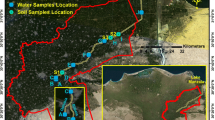Abstract
The village ponds were used for storing rainwater for animals and recharging of underground water. Recent developments like public water supply for household purpose, provision of household wastewater concrete channels, and toilet septic tanks have polluted the village ponds. The infiltration of water has decreased due to non-cleaning of silt from the pond beds. Increased discharge of wastewater from households, coupled with a low infiltration rate, has inundated these ponds. People have abandoned the use of this water for animals. An effort has been made to assess the suitability of this water for irrigation in the vicinity so as to clean these ponds. Seventy-eight water samples were collected from the village ponds in the Ludhiana district of Punjab. The samples were analyzed for total solids (TS), total dissolved solids (TDS), total suspended solids (TSS), biological oxygen demand (BOD), chemical oxygen demand (COD), electrical conductivity (EC), residual sodium carbonate (RSC), nitrogen, water soluble P and K, as well as micronutrients and pollutant elements. The total solids content of these waters were on the higher side. Considering TSS, BOD, and COD, some of these waters are unsafe for their disposal in river or water bodies. Electrical conductivity ranged from 693 to 5050 μmhos/cm, and RSC varied between –1.9 and 22.8 meq/l. The inorganic N (NH\(_{4}^{+}\) + NO\(_{3}^{-}\)-N) and total Kjeldahl N ranged from 3 to 30 and 8 to 41 mg/l, respectively. The amount of micronutrients (Zn, Cu, Fe, and Mn) present in pond water indicated its high nutrient value. The content of the pollutant elements such as nickel, cadmium, and lead was below the maximum permissible limits, thereby indicating its suitability for irrigation. According to the EC and RSC criteria, 18% of the samples were fit, 31% were marginal, and 51% were unfit for irrigation. The data indicate that these waters are a good source of nutrients for agriculture.
Similar content being viewed by others
References
APHA. (2002). Standard methods for the examination of water and waste water. 20th ed. Washington, DC: American Public Health Association.
Balwinder-Singh, & Bishnoi, S. R. (2004). Contribution of underground irrigation waters towards potassium in soils of Moga district (Punjab). Journal of Potassium Research, 20, 118–120.
Bhumbla, D. R., & Abrol, I. P. (1972). Is your water suitable for irrigation? Indian Farming, 22, 15–17.
Branson, R. L., Pratt, P. F., Rhoades, J. D., & Oster, J. D. (1975). Water quality in irrigated watersheds. Journal of Environmental Quality, 4, 33–40.
Brar, J. S., & Sekhon, K. S. (2002). Quality of pond water for irrigation in Muktsar area of Punjab, India. Journal of Research, Punjab Agricultural University, 39(3), 354–356.
Chawla, J. K., Khepar, S. D., Siag, M., & Kumar, D. (2001). Quality status and optimum utilization of village pond water. Indian Journal of Environmental Health, 43(3), 114–118.
Datta Munshi, J., & Datta Munshi, J. S. (1995). Fundamentals of fresh water biology (p. 22). New Delhi, India: Narendra Publishing House.
Eaton, F. M. (1950). Significance of carbonates in irrigation waters. Soil Science, 39, 123–133.
Goel, P. K., & Trivedi, R. K. (1984). Some considerations on sewage disposal to fresh water and resultant effects. Pollution Research, 3, 7–12.
Golterman, H. L. (1975). Physiology limnology (p. 489). New York, NY: Elsevier Scientific Publishing Company.
Gupta, I. C., & Jain, B. L. (1992). Salinization and alkalinization of groundwater pollution due to textile hand processing industry in Pali. Current Agriculture, 16, 59–62.
Indian Standards Institution. (1981). Tolerance limits for industrial effluents discharged into inland surface waters: IS 2490 part I. General limits (second revision). New Delhi, India: Indian Standards Institution.
Indian Standards Institution. (1985). Tolerance limits for inland surface waters subject to pollution: IS 2296. New Delhi, India: Indian Standards Institution.
Indian Standards Institution. (2000). Tolerance limits for inland surface waters subject to pollution: IS part III 1985. New Delhi, India: Indian Standards Institution.
Jackson, M. L. (1967). Soil chemical analysis. New Delhi, India: Asia Publishing House.
Kansal, B. D. (1992). Effect of waste disposal on soils and plants. In G. S. Dhaliwal, B. S. Hansara, & N. Jerath (Eds.), Changing Scenario of Our Environment (pp. 197–206). Ludhiana, India: PAU.
Logan, T. J., & Chaney, R. L. (1983). Utilization of municipal waste water and sludge on land—metals. In A. L. Page, T. L. Gleason, J. E Smith Jr., I. K. Iskander, & L. E. Sommas (Eds.), Proceeding of the Workshop on Utilization of Municipal Waste water and Sludge on Land (pp 235–326). Riverside, CA: University of California.
Maiti, P. S., Sah, K. D., Gupta, S. K., & Banerjee, S. K. (1992). Evaluation of sewage sludge as a source of irrigation and manure. Journal Indian Society Soil Science, 40, 168–172.
Rana, B. C., & Palria, S. (1988). Phycological and physico-chemical evaluation of the river Ayad, Udaipur. Journal Phycos, 27, 211–217.
Richards, L. A. (1954). Diagnosis and improvement of saline and alkali soils. USDA Handbook No. 60. New Delhi, India: Oxford and IBH Publishing Company Private Ltd.
Singh, J., & Kansal, B. D. (1985). Amount of nutrients and heavy metals in the sewage water of different towns of Punjab and its evaluation for irrigation. Journal Research, Punjab Agricultural University, 22, 17–24.
Taylor, A. W., & Kilmer, V. J. (1980). Agricultural phosphorus in the environment. In F. E. Khasawneh, E. C. Sample, & E. J. Kamprath (Eds.). The role of phosphorus in agriculture (pp. 545–557). Madison, WI: American Society of Agronomy.
The Tribune. (2003). Depleting water level worries PAU VC. In K. S. Chawla (Ed). Education Section. http://www.tribuneindia.com/2003/20030709/ldh2.htm. Accessed July 9, 2003.
Watanabe, F. S., & Olsen, S. R. (1965). Test of an ascorbic acid method for determining phosphorous in water and NaHCO3 extract from soil. Soil Science Society of America Proceedings, 29, 677–678.
Author information
Authors and Affiliations
Corresponding author
Rights and permissions
About this article
Cite this article
Toor, A.S., Khurana, M.P.S., Sidhu, B.S. et al. Suitability of village pond waters for irrigation—a case study from district Ludhiana, India. Environ Monit Assess 172, 571–579 (2011). https://doi.org/10.1007/s10661-010-1355-1
Received:
Accepted:
Published:
Issue Date:
DOI: https://doi.org/10.1007/s10661-010-1355-1




